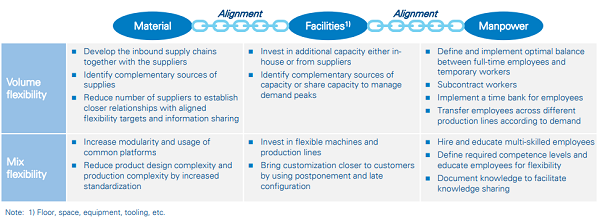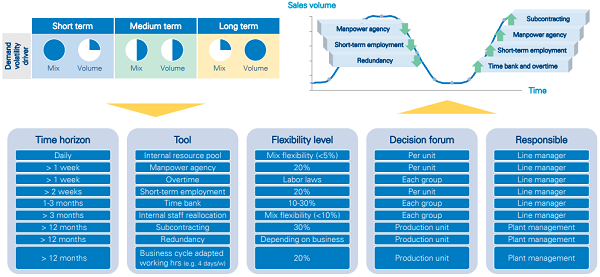It is not a secret that flexibility is a valuable capability for effectively responding to fluctuating customer demand. However, it is crucial for production and supply chain managers to understand how the importance of flexibility has escalated in today’s manufacturing industry. The manufacturing industry faces larger challenges, caused by global trends, than other industries such as telecom and consumer goods.
One of the important trends is increased global competition. The world export of manufactured goods today is three times larger than it was in 2000, which is a much larger increase than for other sectors. Another trend heavily affecting the manufacturing industry is increased volatility in demand. For manufacturing, this volatility is about three times larger than for GDP, much due to the “bullwhip effect.” A factor making it even more difficult for manufacturing companies to cope with demand volatility is broader product ranges, often with different product life cycles.
To tackle the high and unpredictable demand volatility, lean production is not enough. Instead, manufacturing companies must improve responsiveness or, in other words, become Agile. Agility, in this context, means having the ability to rapidly respond to variability in demand, both systematic and temporary, and it is a crucial aspect to succeeding in today’s competitive landscape. In this Advisor, we focus on the production unit.
Agility can generate substantial benefits. By matching customer demand, one can reduce inventory-holding costs, including costs of obsolete products produced to forecast and maintain stable, reliable delivery times. With increased flexibility and shorter time to market, it will also be easier to make faster ramp-ups/downs and more quickly penetrate the market to gain future growth.
Lean production (which, simplified, means “doing more with less”) aims at reducing waste and has helped many companies become more efficient and achieve substantial cost reductions. However, the Lean strategy only provides flexibility within certain boundaries, and is therefore preferable for cases in which the variety is low and the volume high and stable. In contrast, where variety is high and volume per variant is low and unpredictable, it is necessary to be Agile. Lean and Agile are different strategies to match supply and demand, meaning bridging the gap between production and consumption. However, the strategies are not mutually exclusive; Lean is often a prerequisite for agility, and the two strategies are preferable under different circumstances.
Framework and Levers for Agility
A key characteristic of an Agile organization is flexibility, both in terms of volume and in terms of product mix. It is also necessary to be flexible for new product introductions, new options, and customer adaptations. To achieve the required flexibility, it is necessary to be Agile in all different types of manufacturing resources, such as materials, facilities, and manpower. As the resources are heavily interdependent, there also must be a clear alignment of their agility levels for performance and cost optimization.
Companies need a “toolbox” of flexibility measures to improve agility. Examples of tools are shown in Figure 1. The tools have different implications on cost and are therefore preferable under different circumstances. A common mistake among manufacturing companies is to not look at the system effects. It is crucial to see beyond the factory walls and align the agility levels along the supply chain to ensure that low levels of inventory during production do not turn into higher levels of inventory in other departments or for other actors.

Teams working with agility transformation need to be cross-functional to ensure an aligned strategy. This not only enables greater flexibility, as teams can support each other’s success, but is also necessary to avoid one team or department limiting the success of the others.
Increased flexibility will in many cases incur extra costs, as it means machines with increased functionality, larger facilities, and employees with broader competence. When creating business cases for investments in flexibility to transform into a more Agile organization, it is therefore necessary to consider the cost of not being able to satisfy customer demand, or of having excess inventory. To make correct management decisions, one should include the value of being flexible, both today and tomorrow, in investment calculations. To do so, the standardized investment and decision forms have to provide the opportunity to consider these types of benefits.
How to Make the Transformation
To transform into Agile organizations, manufacturing companies have to work proactively and in a structured way. Arthur D. Little (ADL) proposes a process consisting of five main steps:
-
Understand and measure demand volatility. Understand historical demand volatility for different product segments, and estimate future volatility by anticipating changes in the demand pattern and product portfolio plans.
-
Define existing levels of flexibility and set future targets. Understand existing levels of flexibility and set future targets based on factors such as experienced volatility, types of manufacturing processes, costs, and risks. Examples of targets include how much it should be possible to adjust supply and what capacity level is needed for different products to handle both volume and mix fluctuations.
-
Analyze gaps along the supply chain and define actions to close them. Analyze gaps between the current situation and defined targets and develop a toolbox of actions to close them. To become Agile and market driven, companies must gather and analyze information about end-customer demand and link it directly to their production. If not, the “bullwhip effect” will amplify the volatility. It is also necessary to analyze what actually contributes to greater customer value and reduce unnecessary product and process complexity. A common mistake when introducing new products is not phasing out older ones; in other words, not managing the “product tail.”
-
Establish rules and guidelines for using the Agile capability. This includes the characteristics of the different agility tools in terms of lead time to change the possible level of flexibility. It also defines who is responsible and where the decision is taken.
-
Work with continuous agility improvements. Take action for continuous flexibility improvement and develop a plan for the future. The plan needs to be updated on a continuous basis according to changes in customer demands, the production process, and the supplier base, in order to work toward an optimized agility level. An important ingredient to facilitating the transformation is to define KPIs that reflect the flexibility targets. Performance measures shape behavior, and it is therefore necessary that they reflect flexibility and responsiveness to customer demand.
Case Study: Improving Agility at a Manufacturing Company
The client, an engineering and manufacturing company, was struggling with long lead times and high levels of tied-up capital. The problem was not evident when the production, consisting of very complex, large, and customized products, faced high and relatively stable demand. However, as demand grew more volatile, it became apparent that flexibility improvements had to be made to efficiently handle the upturns and downturns the industry was experiencing. In particular, the fact that the delivery times tended to almost double during upturns was a significant business risk. As a result, the management team set challenging targets for lead time and working capital, and needed guidance on how to fulfill the targets without affecting the customer demand and requirements.
Quantitative and Qualitative Analysis
To succeed, the company had to become more flexible. As a first step, we analyzed the company’s existing flexibility levels using quantitative data such as customer orders and lead time, as well as qualitative data from interviews with the production teams and assessment of their competence levels. We compared existing flexibility levels to the targets and, in the gap analysis, identified challenges regarding both mix and volume flexibility. As we assessed the gaps, it became evident how vulnerable the company was to the volatile demand. To close the identified gaps, we defined strategies and tools for the three types of resources: materials, facilities, and manpower:
-
We set material requirements in order to understand the needed mix and volume flexibility levels of suppliers. A key takeaway was the importance of stable, predictable, and short delivery lead times.
-
We improved the design and size of the factory, as well as planning of production flows, creating a line assembly. In addition, we established work teams with specialized competences to optimize assembly times.
-
We created a toolbox with concrete actions to increase manning flexibility for different demand volatility drivers and time horizons (see Figure 2). For all proposed actions, we defined clear targets and responsibilities.

Transformation Plan and Impact
To realize the transformation, we developed a detailed implementation plan for the upcoming six months and a master plan covering the next three years. The estimated result of the project was a 50% reduction of both lead time and working capital. In the future, the company will be equipped to handle volatile demand in a more efficient way, ensuring success for both the company and its customers.
A clear success factor throughout the project was the close cooperation in cross-functional teams and the alignment between the resources. By having representatives from several departments, such as R&D, marketing, production, and strategic sourcing, the company established aligned targets and strategy.
Agility in the Supply Chain Is a Source of Competitiveness
A successful manufacturing company is one that can deliver the right product, at the right time and place, and at the right cost. To succeed with this in tomorrow´s competitive environment, with its increased demand volatility and more challenging trends than ever, manufacturing companies must be Agile. This requires a systematic and cross-functional approach. Overall, companies must become more Agile, as well as find ways to achieve this with minimal effect on unit cost. There are methods and tools available, and the major challenge is to succeed in the transformation effort.




